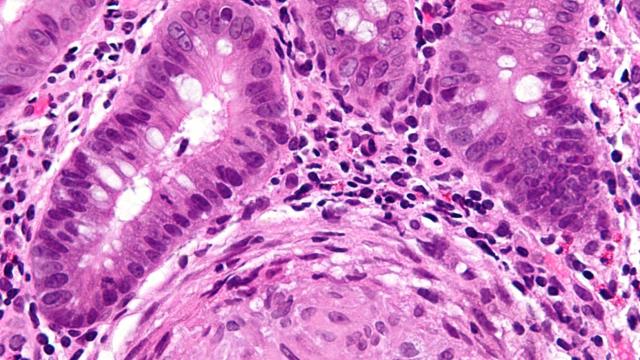A fungal yeast found in cheese and other foods may wreak havoc in the guts of people with Crohn’s disease, according to new findings. In study published Thursday, researchers have found evidence that Crohn’s patients are more likely to carry that yeast than people without the disease, and that this yeast is linked to the slow-healing gut wounds that patients tend to have. If valid, the findings could lead to new treatments and preventative measures for the chronic and painful condition.
Crohn’s is one of the most well-known versions of irritable bowel disease (IBD). There is no clear cause for IBD, but it’s suspected that genetics and a malfunctioning immune system play a large role. Patients experience a wide range of mostly gastrointestinal symptoms caused by chronic inflammation of the gut, which come and go as flare-ups of the disease. These include diarrhoea, fever, intense cramps, and weight loss. Though there are medications that can manage symptoms, along with diets to help people avoid possible triggers of an episode, few sufferers experience sustained remission.
Researchers at the Cleveland Clinic and elsewhere have been studying Crohn’s for a while now in hopes of finding something that could help explain how and why the gut becomes so damaged in these patients. Their new research, published in Science, points to one possible culprit: a fungus called Debaryomyces hansenii.
The scientists studied mice that were made to develop Crohn’s-like symptoms as well as biopsied samples of gut tissue from people diagnosed with Crohn’s. Across both groups, they found an abundance of D. hansenii around wounded or inflamed tissue, but not in samples taken from healthy people or in the uninflamed tissue of Crohn’s patients.
They found the fungi in all of the seven samples taken from a group of Crohn’s patients, for instance, but in only one of the 10 healthy controls used as comparison. They also found evidence that this yeast was directly connected to the slow healing of gut wounds in mice. And when they took samples of the fungi from a Crohn’s patient or diseased mice and gave it to a new group of healthy mice, the mice’s ability to heal gut wounds became worse. This effect was then reversed when mice were given antifungal treatment.
All the findings combined, the researchers say, fulfil Koch’s postulates, a criteria that scientists use for proving that a specific microbe is causing a specific set of symptoms. In other words, it suggests that D. hansenii isn’t just some harmless bystander found in the guts of these patients, but an active source of trouble. At this point, it’s not known how patients might be exposed to the fungi, or if foods rich in the yeast, like cheese, could be one source.
“Our study supports that D. hansenii is safe in healthy individuals, but may be problematic in Crohn’s patients,” said study author Thaddeus Stappenbeck, chair of the Cleveland Clinic Lerner Research Institute’s Department of inflammation and Immunity, in a statement released by the clinic.
The findings are still based on a small group of patients and animal research, so they shouldn’t be seen as definitive proof of the team’s theory. And even if they are right, Crohn’s and IBD in general will likely remain a complex illness with symptoms that can’t be explained entirely by a single microbe. In the mice they studied, for instance, the fungal overgrowth only happened after the mice were given antibiotics. Other research has pointed to antibiotics as a possible risk factor for Crohn’s, since they can disturb the delicate microscopic environment of our gut, called the gut microbiome.
If future research does continue to show a strong link between Crohn’s and D. hansenii, it could lead to important new treatments and strategies for managing the illness. People with active episodes and evidence of infection might benefit from antifungals, for instance. Another area of research could involve targeting how D. hansenii seems to cause gut inflammation in the body, through a protein called CC5 that’s produced by some immune cells. And since the yeast is commonly found in cheese and other processed food, it might be worthwhile for patients in general to avoid these foods, the researchers say.
“Our goal is to now understand how D. hansenii interacts with other components of the microbiome and the host immune system in Crohn’s disease patients to affect its ability to infect damaged areas of the intestine,” said Stappenbeck.
